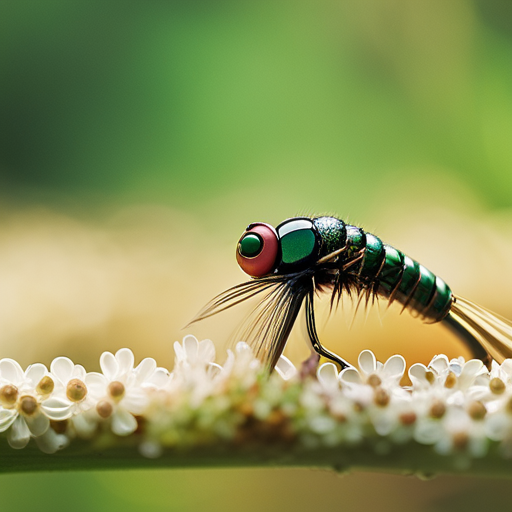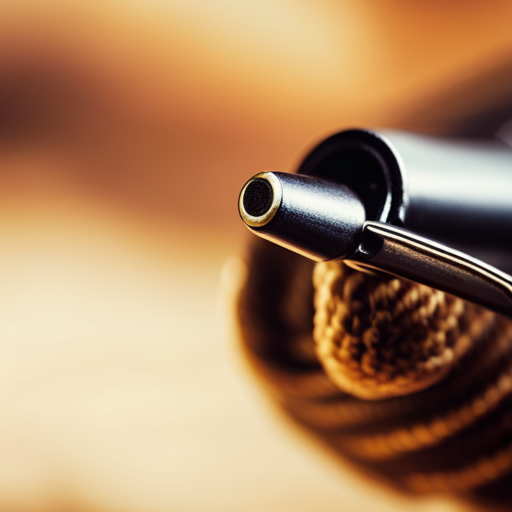Like the delicate brushstrokes of a master artist, the choice of body materials in nymph tying can bring life and realism to fly patterns.
From mimicking the iridescence of natural insects to ensuring durability and lifelike texture, the selection of body materials plays a crucial role in creating effective imitations.
This article delves into the significance of body materials in nymph tying, exploring their impact on sink rate, presentation, and overall success on the water.
Understanding Natural Insect Imitation
Understanding natural insect imitation is essential for creating lifelike nymph patterns that effectively mimic the appearance and behavior of real aquatic insects. When designing fly patterns to imitate natural insects, it is crucial to consider the insect behavior, natural habitat, and fishing techniques.
By observing the behavior of aquatic insects in their natural habitat, fly designers can replicate their movements and appearance in their patterns. This attention to detail is what makes the difference between an ordinary fly and an effective imitation.
Insect behavior varies across species and life stages, and successful nymph patterns must reflect this diversity. For example, the way a mayfly nymph moves through the water differs from that of a caddisfly larva. Understanding these nuances allows fly designers to create patterns that accurately represent the targeted insect.
Additionally, considering the natural habitat of the insects is vital. Different nymphs thrive in various water conditions, and their appearance is often adapted to blend into their surroundings. By replicating these characteristics, fly patterns become more convincing to the fish.
Ultimately, understanding natural insect imitation is fundamental to the efficacy of nymph patterns, as it enhances their ability to attract fish and elicit strikes.
Importance of Durability and Lifelike Texture
When it comes to nymph tying, durability is crucial in achieving a realistic look that can withstand the demands of fishing.
Additionally, using materials that provide a lifelike texture enhances the presentation of the fly, making it more appealing to the fish.
Both durability and lifelike texture play integral roles in creating effective nymph patterns for successful angling.
Durability for Realistic Look
One must prioritize durability and lifelike texture in nymph tying to achieve a realistic look that enhances the fly’s effectiveness.
Durability is crucial as it ensures that the fly withstands repeated strikes and remains intact throughout numerous casts. A nymph with realistic appearance and lifelike texture is more likely to attract fish as it closely resembles their natural prey.
Using durable materials such as synthetic fibers, epoxy resins, and UV-cured materials can help achieve both the desired lifelike texture and long-lasting durability. Incorporating these materials into nymph tying not only improves the fly’s resilience but also enhances its visual appeal, making it a more convincing imitation of aquatic insects.
Ultimately, prioritizing durability for a realistic look in nymph tying can significantly increase the effectiveness of the fly in catching fish.
Lifelike Texture Enhances Presentation
To enhance the presentation of nymphs, the incorporation of materials that provide lifelike texture and durability is essential for attracting fish and withstanding repeated strikes. When considering the importance of lifelike texture in nymph tying, it is crucial to focus on the following:
-
Realistic Appearance
-
Using materials that mimic the natural appearance of aquatic insects enhances the nymph’s visual appeal to the fish.
-
Realistic textures and colors create a more convincing imitation of natural prey, increasing the likelihood of attracting fish.
-
Natural Movement
-
Materials with lifelike texture allow for natural movement in the water, replicating the subtle motions of real aquatic insects.
-
Mimicking the natural movement of nymphs adds to the overall effectiveness of the fly in enticing fish to strike.
These elements collectively contribute to the overall effectiveness of the nymph presentation.
Now, let’s delve into exploring versatile body material options.
Exploring Versatile Body Material Options
When it comes to tying effective nymph patterns, the choice of body material plays a critical role in determining the fly’s success in imitating natural insect forms.
Exploring a range of versatile body material options allows fly tyers to create patterns that closely mimic the lifelike texture and appearance of aquatic nymphs.
The varied body material choices have a direct impact on the effectiveness of the fly in catching the attention of targeted fish species.
Varied Body Material Choices
The selection of body materials for nymph tying plays a crucial role in achieving varied and versatile fly patterns. When considering varied body material choices, it is essential to weigh the advantages of synthetic vs natural options. The decision should also take into account the texture and color of the materials.
- Synthetic vs Natural
- Synthetic materials offer durability and consistency in texture and color.
- Natural materials such as feathers and fur provide a lifelike appearance and natural movement in the water.
The choice of body material greatly influences the overall appearance and behavior of the nymph fly, affecting its effectiveness in imitating aquatic insects. Now, let’s delve into the impact of body material choices on the fly’s effectiveness.
Impact on Fly’s Effectiveness
Exploring the impact of body material choices on the fly’s effectiveness requires a comprehensive understanding of how different materials contribute to the lifelike appearance and natural movement essential for imitating aquatic insects. The material impact is crucial as it directly affects the fly’s ability to attract and catch fish. By carefully selecting body materials, fly tiers can enhance the effectiveness of their creations. Some materials may impart more realistic movement, while others may offer increased durability. Additionally, certain materials may excel in imitating specific aquatic insects, further boosting the fly’s effectiveness. To illustrate the diverse impact of body materials, consider the following table:
| Material | Effectiveness Contribution |
|---|---|
| Natural Feathers | Realistic movement and appearance |
| Synthetic Fibers | Enhanced durability and versatility |
| Dubbing | Imitation of specific insect species and natural appearance |
Understanding the implications of body material choices is fundamental in creating effective nymph patterns.
Enhancing Sink Rate and Depth Control
How can nymph fly tyers enhance sink rate and depth control using specific body materials?
When it comes to enhancing sink rate and depth control, the choice of body materials plays a crucial role in the effectiveness of weighted nymphs. Synthetic materials offer various advantages in achieving the desired sink rate and depth control for nymph flies.
-
Synthetic materials provide consistency in weight distribution, ensuring a predictable sink rate and precise depth control.
-
This consistency is particularly beneficial when tying weighted nymphs designed to reach specific depths in the water column.
-
Additionally, synthetic materials allow for the incorporation of specific densities, enabling fly tyers to customize the sink rate of nymphs to match different water conditions and target species.
-
By adjusting the density of the body materials, fly tyers can effectively tailor the sink rate and depth control of nymph flies to suit varying fishing scenarios.
Utilizing UV and Reflective Properties
When utilizing UV and reflective properties in nymph tying, fly tyers can further enhance the effectiveness of their flies by incorporating specific body materials that optimize visibility and attraction in varying light conditions.
UV protection is a crucial aspect to consider in fly tying, as it helps the fly to stand out and remain visible in different light environments. Materials with UV-reflective properties, such as UV-enhanced threads or synthetic materials, can be used to create a shimmering effect that catches the attention of fish, even in low-light conditions.
Additionally, incorporating a reflective surface into the body materials of the nymph can increase its visibility by reflecting light and creating flashes that mimic the natural appearance of aquatic insects. This can be achieved by using materials like holographic tinsel or flashabou, which provide a reflective quality to the fly, making it more attractive to fish.
Considerations for Water Absorption and Buoyancy
One key consideration for nymph tying is the selection of body materials that provide optimal water absorption and buoyancy for the fly. When considering water absorption and buoyancy, the following factors should be taken into account:
-
Water Repellency
Some materials, such as certain synthetic fibers or water-resistant natural materials like CDC feathers, offer excellent water repellency. This property can help the fly stay afloat and resist becoming waterlogged during prolonged casting and drifting. -
Material Density
The density of the body material affects the fly’s buoyancy. Lighter materials, like foam or certain types of dubbing, can help the fly ride higher in the water column, mimicking the natural behavior of nymphs as they emerge or drift in the current.
These considerations are crucial for achieving the desired presentation and behavior of the nymph fly in the water. Understanding the impact of water absorption and buoyancy on fly performance is essential for creating effective imitations that can attract fish and lead to successful angling outcomes.
Now, let’s delve into the impact of these body material properties on fly presentation and success on the water.
Impact on Fly Presentation and Success on the Water
The impact of body material properties on fly presentation and success on the water is substantial and multifaceted. Material flexibility plays a crucial role in determining how a nymph fly moves in the water. Flexibility allows for natural movement and lifelike behavior, enticing fish to strike. When selecting body material for nymph tying, it is important to consider the natural movement that the material will impart to the fly underwater. Different materials offer varying degrees of flexibility, and choosing the right one can greatly enhance the effectiveness of the fly presentation.
Color selection is equally important in determining the success of a nymph fly on the water. The color of the body material can affect the visibility and attractiveness of the fly to fish. It is essential to consider the prevalent underwater conditions, such as water clarity and light penetration, when choosing the color of the body material. Additionally, understanding the natural prey in the specific fishing environment can guide the selection of body material color to closely mimic the aquatic insects or other organisms that the fish are feeding on.
Frequently Asked Questions
What Are the Best Body Materials for Tying Nymphs in Fast-Moving Water?
For nymphs in fast-moving water, the best body materials are those that mimic the natural appearance and movement of insects. Natural materials like peacock herl and pheasant tail fibers provide realism, while synthetic materials like UV ice dubbing offer durability and versatility. Techniques for creating realistic bodies include using ribbing materials to imitate segmentation and incorporating materials with translucency and iridescence to mimic the natural look of nymphs.
How Does the Weight of Body Materials Affect the Sink Rate of Nymph Flies?
The weight distribution of body materials significantly impacts the sink rate of nymph flies. Proper weight distribution enhances casting accuracy and influences the fly’s ability to mimic natural insect movement underwater, ultimately attracting fish.
Are There Any Body Materials That Are Particularly Effective for Imitating Specific Insect Species?
When considering imitation effectiveness and matching hatches in nymph tying, certain body materials can be particularly effective for mimicking specific insect species. Understanding the characteristics of these materials is crucial for successful imitation.
How Can Body Materials Impact the Overall Durability of a Nymph Fly?
Nymph durability is influenced by body materials. Synthetic materials offer enhanced longevity compared to traditional options. The choice between natural and synthetic nymph body materials directly impacts the fly’s overall durability, ensuring resilience and effectiveness on the water.
What Are Some Unique Ways to Incorporate UV and Reflective Properties Into Nymph Fly Designs?
Innovative techniques in nymph fly design incorporate UV materials for increased visibility and reflective properties to imitate natural prey. Incorporating UV reflective materials in nymph tying enhances the fly’s attractant properties and increases its effectiveness in mimicking aquatic insects.
Conclusion
In conclusion, the selection of body materials in nymph tying plays a crucial role in imitating natural insects, ensuring durability and lifelike texture, and enhancing sink rate and depth control.
While some may argue that the variety of body material options can be overwhelming, it is important to consider the specific properties of each material and their impact on fly presentation and success on the water.
By carefully choosing the right body material, anglers can improve their nymph patterns and increase their chances of catching fish.




